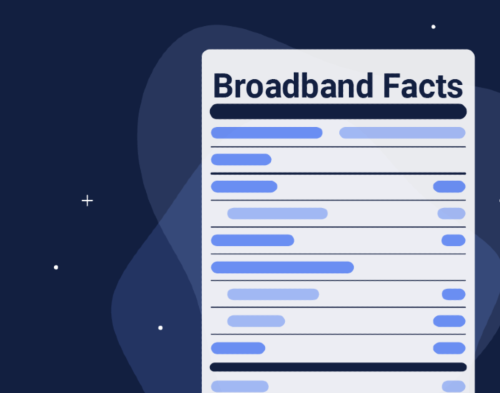

Consumer protections make the internet a better place
The internet is as essential to daily life as recognized public utilities like electricity and telephone service. In contrast to those heavily regulated utilities, however, the internet has always been the Wild West. Internet providers could extract huge amounts of money from customers through hidden fees, data caps, and price hikes, especially in areas with few options.
Fortunately, changing technologies and increased consumer protections have reduced the power of regional telecom monopolies, giving internet users more power to choose the internet plan that best suits their needs. The biggest step in this direction in recent years was the FCC’s adoption of mandatory broadband labels, which finally meant the end of hidden fees and deceptive marketing practices.
Or at least it will if we take them seriously.

What are Broadband Labels?
Broadband Labels provide internet customers with access to comprehensive and accurate information about their internet plans. This includes information about any potential fees, long-term contracts, or data restrictions included in the plan.
Often called “Broadband Nutrition Labels” for their design that intentionally emulates the look of FDA-mandated nutrition facts on food, the FCC’s broadband labels are meant to fill a similar role. In addition to providing basic information, nutrition labeling rules also combat the false health claims and misinformation that once plagued processed foods. Internet plans, likewise, should give consumers the information they need to make informed choices.
Internet service providers are required to display the labels at the point of sale so that consumers can more easily compare plans. As soon as you’ve entered your location information while shopping online, labels should appear next to every plan you’re shown.
While it’s still too early to assess the impact of these labels on consumers, their effect on providers was immediate. In the lead up to the labels’ implementation, many providers started doing away with their additional fees and simplifying their pricing structures. By the time the labels went live, most of the hidden fees they were meant to expose were already gone. Funny coincidence, I suppose.
Pushing the boundaries
When the FCC announced its final rules for broadband labeling, I first asked whether or not we’d see providers trying to sneak around these guidelines by finding loopholes or blurring the lines around certain terms. Providers have a long history of abusing terms like “unlimited data” because technically, even if they charge you outrageous overage fees or aggressively throttle your connection for going over your data limits, that trickle of deprioritized dial-up speed data is still unlimited if you squint hard enough.
For this reason, the FCC was very specific in the information that had to be included on the labels. “Pass through” fees must be listed in an itemized list if the provider intends to add them to the customer’s bill. Data included in a plan only counts if it is included in the normal monthly price with no extra fees or decreased performance.
While I haven’t yet seen any providers blatantly lying to their customers, I have seen several providers testing the boundaries in other ways, particularly in how labels are displayed online. The FCC left no ambiguity in its final order:
Providers must display the actual label—not simply an icon or a link to the label—in close proximity to the associated plan advertisement. By requiring providers to place the label close to their advertising, we expect consumers will more easily be able to make a side-by-side comparison of the advertised plan’s cost and features with the information required in the label.
Nevertheless, some providers offer nothing more than a legal-disclaimer-sized link to their labels below their plan options. In other cases, the labels don’t appear until the plan is in your online shopping cart—when you’re clearly past the point of side-by-side comparison.
Raising the alarm about deviations in website layout and structure might seem like nitpicking. And, admittedly, it is. Chances are if you’ve already made it halfway through this article on telecom policy, you’re more than savvy enough to find the important information about an internet plan, even if it’s not displayed where it should be. But I guarantee you know someone who doesn’t know their way around the internet. We’ve all known a parent, neighbor, or coworker who has been overpaying for bad internet service without realizing it. Broadband labels are meant to help these people.
What can we do?
Even if our internet providers’ shenanigans don’t inconvenience us much, we shouldn’t accept their bad behavior. Like a petulant toddler poking their sibling on a long road trip, we know that the problem’s not going to get better if we just ignore it. And we know how bad the problems can get. It’s not surprising that internet providers frequently make lists of the most hated companies in America alongside the likes of discount airlines and Monsanto.
If you see an internet provider being shady about displaying their broadband labels, the FCC has a complaint form you can fill out. If they’re deliberately making it hard to compare the options available in your area, you can use a third-party internet comparison site. You can also reach out to friends and family struggling to find an internet plan that meets their needs and help them find the information they need to make an informed choice.
While there are still issues with implementing broadband labels, most providers are willingly complying with the program, and it’s hard to overstate how much this improves the internet for everyone. If we stick to our guns and demand that companies give us the information we’re entitled to, the idea of hidden fees and throttled connections might someday seem as shocking as finding mystery ingredients in our food.


